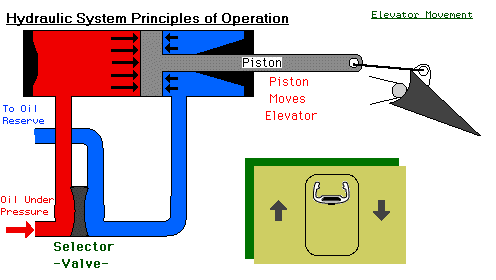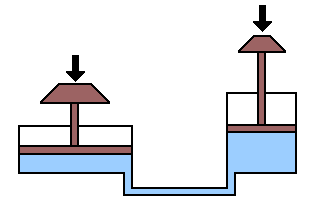 |
|||||
| Home | Research | For Teachers | HISTORY Level 1 Level 2 Level 3 |
PRINCIPLES Level 1 Level 2 Level 3 |
CAREER Level 1 Level 2 Level 3 |
| Gallery | Hot Links | What's New! | |||
| Web Administration and Tools | |||||
 |
|||||
| Home | Research | For Teachers | HISTORY Level 1 Level 2 Level 3 |
PRINCIPLES Level 1 Level 2 Level 3 |
CAREER Level 1 Level 2 Level 3 |
| Gallery | Hot Links | What's New! | |||
| Web Administration and Tools | |||||
![]()
Pressures in hydraulic systems can be extremely high and normally are measured in
thousands of pounds per square inch (psi) when using British units of measurement, or
pascals (Newtons/square meter).
Part of the hydraulic system is the actuating cylinder whose main function is to change
hydraulic (fluid) power to mechanical (shaft) power. Inside the actuating cylinder is a
piston whose motion is regulated by oil under pressure. The oil is in contact with both
sides of the piston head but at different pressures. High pressure oil may be pumped
into either side of the piston head.
The diagram below shows an actuating cylinder controlled by a selector valve. The
selector valve determines to which side of the actuating cylinder the high pressure oil
(red colored side) is sent. The piston rod of the actuating cylinder is connected to
the control surface, in this case, an elevator.

As the piston moves out, the elevator moves down. As the piston moves in, the elevator
moves up. The selector valve directs the high pressure oil to the appropriate side of the
piston head causing movement of the piston in the actuating cylinder. As the piston moves,
the oil on the low pressure side (blue colored side) returns to the reservoir since return
lines have no pressure!
The differential in oil pressure causes movement of the piston. The force generated
by this pressure difference can be sufficient to move the necessary loads. Each
cylinder in the plane, boat, etc., is designed for what it must do. It can deliver the
potential it was made for; no more, no less. Air loads generally determine the force
needed in aircraft applications. For example, if a force of 40,000 pounds is required and
the high pressure oil is pumped in at a pressure of 1000 psi, then the piston is designed
to have a surface area of 40 square inches on which the oil acts.
A hydraulic system transmits power by means of fluid flow under pressure. The rate of
flow of the oil through the system into the actuating cylinder will determine the speed
with which the piston rod in the actuating cylinder extends or retracts. When the cylinder
is installed on the aircraft, it is already filled with oil. This insures that no
air bubbles are introduced into the hydraulic system, which can adversely affect the
operation of the system.
The method by which fluid is used to create force was explained by Pascal. In a confined stationary liquid, neglecting the effect of gravity, pressure is distributed equally and undiminished in all directions; it acts perpendicular to the surface it touches. Because the actuating cylinder is not vented, the force delivered through the piston to the surface of the fluid is translated into a pressure on the surface of the fluid.
The pressure (p) acting on the incompressible oil does work [(pressure) x (Area of piston) x (piston's stroke) = Work]. In the diagram below, the force acting on the right side piston does work and moves the fluid from the right cylinder to the left cylinder. The fluid movement into the left cylinder creates a pressure on the left piston's surface area. That in turn creates a force that moves the left piston up.
Pascal's Law states that the pressures in both cylinders are the same (p1=p2). Thus, given a force, F1, of 10 pounds (lbs) in the right cylinder acting on a piston area, A1, of 2 square inches (sq. in.) a pressure in the right cylinder, p1, of 5 pounds per square inch (lbs/sq. in. = psi) is produced. Now if A2 is given as 5 sq. in., then the force developed in the left cylinder is F2 = p2xA2, or 25 lbs. This is due to the fact that p1=p2. Thus Pascal's Law shows the way in which one can increase the output force for a given input force...regulate the areas of the pistons!

![]()
The only disadvantage is the size of the piston stroke involved. Let's say, piston 2 moves (up) 10 inches. For the previous problem the work done by piston 2 is F2 times the stroke of piston 2 (10 in. x 25 lbs). If no losses exist in the system due to friction, then work is conserved and piston 1 must do 250 in-lb of work. Therefore, the F1 must move down 25 inches (250 in-lbs/10 lb force)! To move piston 2 up, a volume of 50 cubic inches (cu. in.) of incompressible oil must be pumped in at 5 psi (since pressure times Volume is also another way to find work). The movements of the pistons are measured relative to the bottom of the cylinder with all the measurements computed to produce 100 % efficiency.
The disadvantage with this idea is that you must remove the old tubing and replace it with new tubing that can withstand the new loading.
That may be restricted by the size of the actuating cylinder you can place in the location slated for the cylinder.
This may also be restricted by the location of the actuating cylinder 1.
Just to reinforce what was said before: the distance of piston movement for the piston in the output cylinder is determined by the volume of oil being pushed into the output cylinder.
![]()

An example of a hydraulic system that we deal with every day is the brake system in our cars. That system is an example of the material we have just discussed. Look at the picture given below. When the brake pedal is pressed down, the piston in the 1st cylinder goes down, pushing the oil through the tubing into the little wheel actuating cylinder near the brake shoes. The oil, in turn, pushes the little pistons out and this, in turn, pushes the shoes up against the brake drum causing the car wheel to be slowed to a stop.
Send all comments to ![]() aeromaster@eng.fiu.edu
aeromaster@eng.fiu.edu
© 1995-98 ALLSTAR Network. All rights reserved worldwide.
Updated: February 23, 1999